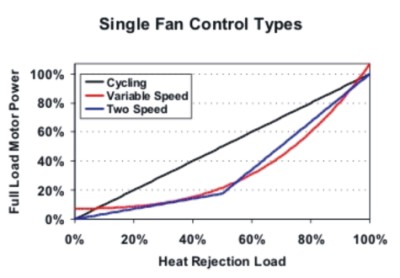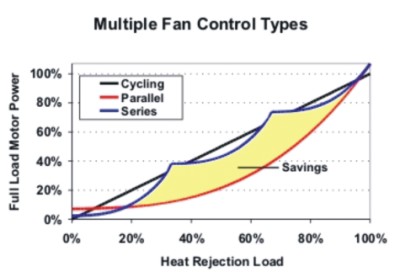
We typically find that cooling tower, condenser and other heat rejection fans are often not optimally controlled, even if the fans on the equipment have variable speed capability. Read on to see if you can substantially reduce your energy costs with a simple controls programming change.
Basics
The purpose of heat rejection equipment is to remove heat from chilled water, refrigeration, process and other equipment. Heat rejection equipment includes cooling towers, fluid coolers, and condensers (air-cooled and evaporative). Air is moved across a coil or wetted medium to remove heat from the system. Heat rejection fan control methods can largely determine the energy used by the heat rejection system.


Single Device Control Methods
There are generally three ways to control heat rejection fans. In order of least efficient to most efficient they include cycling the fan(s), using a two-speed fan, or using a variable frequency drive. Theoretically, a fan running at half speed only requires 12.5% of full load shaft power. The two-speed and variable speed options use virtually the same energy as shown in the Single Fan Control Types Chart. Variable speed fans use slightly less because they can precisely control speed and power to match the load.
Let’s compare the energy required to run a heat rejection device with cycling controls and variable speed controls at 50% load.
In this case a two-speed motor would use about the same amount of energy as the variable frequency drive controlled fan motor. If the load dropped below 50%, the two-speed motor would cycle between 50% load and off; if the load were greater than 50% the two-speed motor would cycle between 100% and 50% speed. The Multiple Fan Control Typhes chart shows theoretical energy consumption at different loads for the different control types.
Multiple Device Control Methods
For larger installations that require multiple heat rejection devices, or devices with multiple “cells” and fans, there is another aspect to the control scheme that must be examined. This is where control sequences typically go awry. Should the separate heat rejection devices be controlled in series or parallel? Series control consists of starting one fan and ramping the speed up until it reaches 100%, then starting the next fan and ramping that up, and so on. Parallel control consists of bringing each fan online at minimum speed until they are all operating and then running all fans at the same speed, at the same time.
Parallel fan operation is the more efficient method for controlling heat rejection devices because it uses the entire heat rejection surface to the maximum extent possible. Series control typically wastes this heat rejection surface, which costs a lot of money. The graph below shows the energy consumption for three separate heat rejection devices with different sequencing methods.
The space between the blue line (series control) and red line (parallel control) represents potential savings. The savings for this three-fan system is probably about 33% over a typical annual operating period, considering the system is likely to operate between 25% and 75% of capacity nearly all the time. And what does this measure cost? Almost nothing when you have the drives and digital controls already in place.




